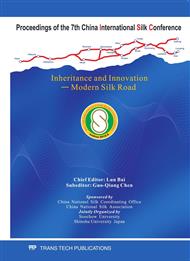p.90
p.95
p.100
p.105
p.110
p.116
p.121
p.127
p.132
Preparation and Characterization of Silk Fibroin Microspheres
Abstract:
An improved method of water-in-oil-in-water (w1/o/w2) multi-emulsion was developed to prepare silk fibroin (SF) microspheres that had improved drug-loading amount and better drug-loading efficiency. SF and dexamethasone sodium phosphate (DSP) were used as one water phase(w1), liquid paraffin was used as oil phase and isopropanol was used as the other water phase(w2). In the preparation process, isopropanol was also used to induce the crystallization of SF. The SF microsphere was mainly composed of silk II proteins. The drug-loading amount of SF microsphere ranged from 28.45 µg/mg to 79.21 µg/mg, and the drug-loading efficiency varied from 30.80% to 87.16%. The spherical morphology of the microsphere was observed by SEM. The particle diameter was measured by the Laser particle sizer and their average sizes varied from 7.41 µm to 66.10 µm. The drug releasing profile of the microspheres was measured in vitro. The burst release was significant when isopropanol-to-SF ratio was lower than 3:1,although the drug-loading amount and the drug-loading efficiency was high; It showed a higher drug-loading amount and efficiency, as well as an obvious continuous release effect when the ratio was higher than 4:1; It also showed a certain continuous release effect when the ratio was 4:1.
Info:
Periodical:
Pages:
110-115
Citation:
Online since:
January 2011
Authors:
Keywords:
Price:
Сopyright:
© 2011 Trans Tech Publications Ltd. All Rights Reserved
Share:
Citation:


